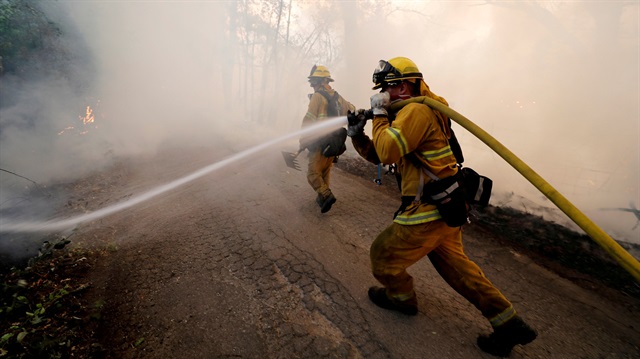
Veverka overseas one of Cal Fire's team of prison inmates who are placed on the fire line, in exchange for about $25 a day and a reduction of their sentences.
In the "off-season," he exercises every day to prepare for the demanding summer firefights. Some prison inmates are not as fit, and about five times a summer, a helicopter has to airlift prisoners suffering from heat exhaustion, he said.
Crews typically work a 24-hour shift followed by a 24-hour rest period typically in a motel, Cal Fire officials said.
After crews spend 14 days on alternating work and rest periods, authorities try to give them a two-day break, Berlant said. But sometimes crews must wait three weeks for their two-day break, he said.
Veverka, from Alturas, California, and his crew have at times gone 40 or 50 days before receiving a two-day break, he said. Berlant acknowledged Cal Fire crews sometimes received such long assignments, but said it was rare.
The Carr Fire, which has killed four civilians and two firefighters, has been particularly demanding for firefighters. The long shift Veverka and his crew worked when they arrived was typical of what other crews worked that day, according to the local fire chief.
Shasta County Fire Chief Mike Hebrard told a news conference on Sunday that some were working 48 hours straight. "They were just going on pure adrenaline."
Veverka was activated to wildfire duty on July 1. In a typical year, his deployment winds down by the end of October.
But California fire officials have repeatedly warned the fire season is getting longer and more intense. The Thomas Fire erupted in December in Ventura and Santa Barbara counties and became the largest in state history.
Higher temperatures have helped extend the period of wildfires by 60 to 80 days each year, National Interagency Fire Center spokeswoman Jennifer Jones said.
The U.S. Forest Service has a different work shift structure from Cal Fire. Forest Service crews typically work 16-hour shifts, followed by eight hours of rest, with two days of rest after 14 days on assignment, officials said.
Research has shown that, over time, it can take a long-term toll on the bodies of the men and women protecting homes, businesses and natural landmarks.
"Over time, the body is not able to respond as well, and one of the things we typically see is firefighters get sick," Joseph Domitrovich, exercise physiologist with the Forest Service, said in a phone interview.
"It's where their immune system, with repeated activity or fire work stress, they tend to get what we call 'camp crud,' which is an upper respiratory tract infection."
Physical exhaustion has also been blamed for a number of safety mishaps that have killed firefighters.
For instance, four firefighters died in 2001 when they were caught in the Thirtymile Fire in Washington state. The U.S. Forest Service, in a report, said fatigue was a factor in the poor decision-making that led up to the deaths.
The night before their deaths, the firefighters had only slept for one to three hours while traveling to the fire, the report said.


















